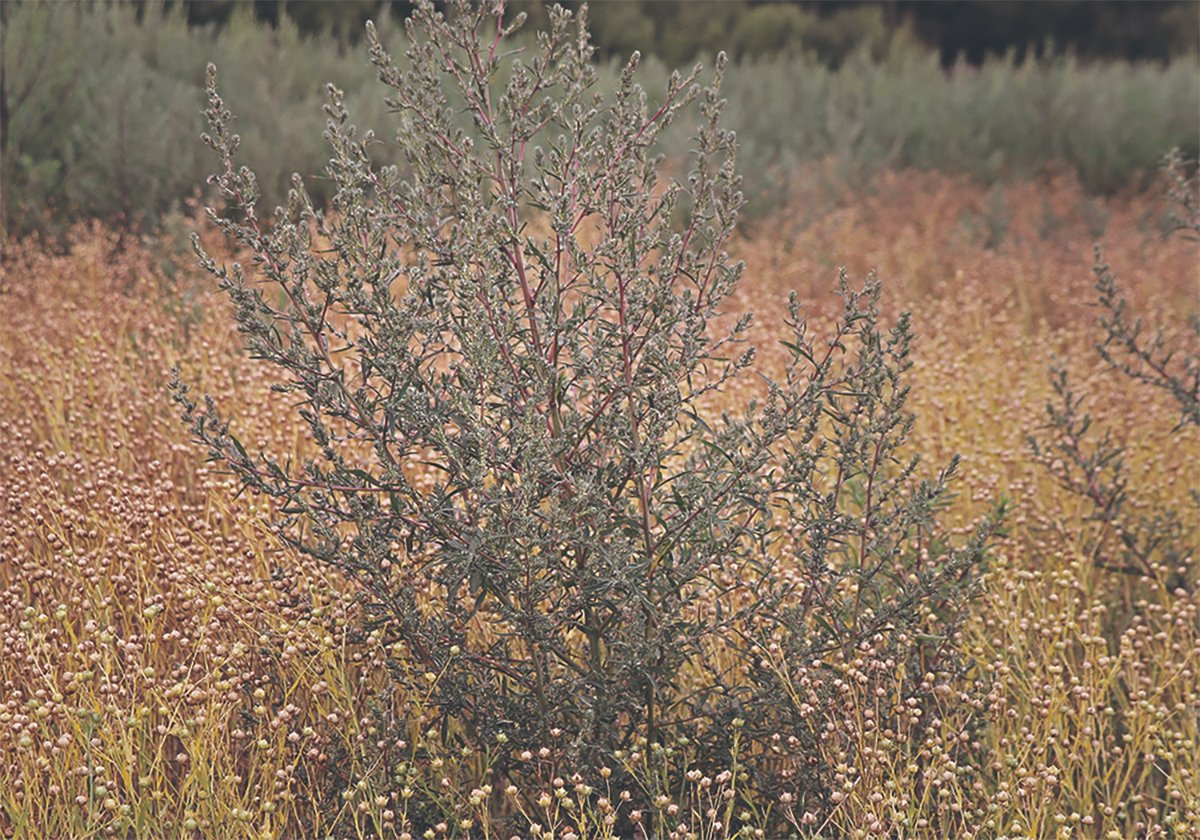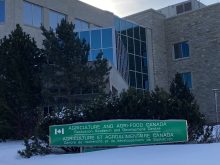Wildlife officers
Your article “Hunting for law breakers” (WP, Dec. 23) is an indication of some of the things wrong with Saskatchewan.
Mr. Artymichuk boasts about some of his activities as a conservation officer. He states that he carries a rifle, a baton, pepper spray and a handgun. It sounds like he’s armed and dangerous Ñ more dangerous than most hunters.
He also mentions setting up dummy animals trying to get hunters to shoot at them. That sounds like entrapment, which is surely unethical if not downright illegal and not admissible evidence in most courts.
Read Also

Kochia has become a significant problem for Prairie farmers
As you travel through southern Saskatchewan and Alberta, particularly in areas challenged by dry growing conditions, the magnitude of the kochia problem is easy to see.
A brother-in-law living in the Bruno area of Saskatchewan was stopped and checked several times this fall while travelling back and forth feeding cattle. He was not hunting and there was no reason for anyone to suspect that he was.
That smacks more of harassment than law enforcement. It’s a small wonder why there is an element in society that has little respect for authority. When authority is abused, law abiding citizens lose respect for authority.
With 140 conservation officers scouring the bushes harassing Saskatchewan residents, I’m sure many people are being discouraged from hunting. Meanwhile dozens of animals are involved in collisions with vehicles daily, and farmers suffer many millions in losses to wildlife and waterfowl every year.
The Saskatchewan government might be wise to lay off about 100 unnecessary wildlife officers and use the money saved to help pay for the damage caused by wildlife.
Ñ Roger Brandl,
Fort St. John, B.C.
Have a beer
Thank you to the NDP government for fulfilling the commitment they made to the farmers of Saskatchewan by fully funding their portion of the CAIS (Canadian Agricultural Income Stabilization) program.
During the last year, while the provincial government was not willing to fully fund this program, there was beer consumed in this province. The farmers were paid $3.25 per bushel of barley, which is the main grain used in the production of beer. That bushel of barley generates 52.5 dozen bottles of beer, which amounts to 62 cents worth of barley in a $24 case of your favourite brand at your local small town tavern.
But wait, what is the provincial government’s share? There is a 10 percent consumption tax on beer sold in Saskatchewan. By now you can see the provincial government has received $126 of revenue from that bushel of barley.
If a farmer produces a 50 bu. per acre crop of malt quality barley, the provincial government receives $6,300 in revenue from their consumption tax on every acre that farmer produced.
Don’t forget the farmer received $162.50 for that acre of barley. The number of acres of malt barley needed to cover the provincial government’s top up of the $110,000,000 amounts to approximately 17,460 acres.
On our farm, we grow 5,400 acres of barley annually. Assuming we have an average crop of 50 bu. per acre and the barley is high enough quality to make malt, we have contributed $3.15 million to the provincial coffers and received $81,250 as my share and I do not qualify for a CAIS payment.
The next time you hear the NDP cheering for themselves by going to the wall for the farmers of Saskatchewan, have another beer. As a matter of fact, you will need to drink the full dozen before you are able to believe the provincial government is being hurt by fulfilling a commitment they made to the farmers.
Ñ Roy Bailey,
Milden, Sask.
Beekeepers
Re: Beekeepers fight over checkoff (WP, Dec. 23).
He who pays the piper calls the tune? Yes, David Sawkiw is right: there is a problem with a commission as proposed and with the Saskatchewan Beekeepers Association. The problem is that both give beekeepers like David Sawkiw one vote, (in his case that is one vote for 50 hives) just as they give one vote for 1,000 or 2,000 or 3,000 hives.
Of course people like David Sawkiw want no change to this. To the contrary: they want more voice than they deserve, like having an article printed in this paper or carrying most of the opposition at the last SBA meeting.
This issue of representation has been going on for a long time and any change has been stalled by the fear that a few large producers may decide the fate of the SBA or in this case the commission.
I think they should. At the moment, it only takes one member … to render my vote nil and that is not right.
The formation of a commission has the potential to render the SBA obsolete and all the David Sawkiws irrelevant. A workable compromise would be a board of three SBA delegates elected as before (one member-one vote) and three commission delegates elected proportionally (one contributing hive-one vote.)
If David Sawkiw convinced all the beekeepers in the province of Saskatchewan to contribute to the research fund as much per hive as I have, there would be no need for a commission.
Ñ Yves Garez,
Nipawin, Sask.
Beekeeper voice
In the Dec. 23 edition of your newspaper, you reported that the Saskatchewan Beekeepers’ Association was attempting to form a commission and that this action was quite controversial within our industry.
You are creating a controversy where one does not appear to exist. We initiated discussions regarding the formation of a commission at our annual meeting in February 2004. There was enough general support for the proposal that the SBA board decided to make a further assessment of the mood of the beekeepers in the entire province and not only those choosing to belong to our association.
Accordingly, a letter of explanation was sent to all provincial beekeepers, including hobbyists. … One hundred and sixteen beekeepers responded to the original mail out and only three of the respondents were not in favour.
The respondents represented approximately 50,000 honeybee colonies and the majority preferred assessment based on hive count. The colony count for the no’s was 75 in total and therefore completely insignificant, as the levy would not be applied to them. …
The topic was fully discussed at the field day and a motion was passed, again by a large majority, that the board proceed to put in place documentation outlining just how the commission would function, and that the document be brought to the fall business meeting, to be held in November, for a final ratification. …
Once the legal document has been prepared, it will be sent to all beekeepers to be affected by it Ñ probably those beekeepers operating 100 or more colonies, and therefore considered to be commercial operators.
This mailing will go to all commercial beekeepers in the province, and not just those belonging to the SBA.
Their vote at that time will determine whether or not we proceed with the commission. The vast majority of our beekeepers realize that our industry cannot rely on government to do our research and promotion, and that the responsibility for these activities lies with us. We can’t do those things without funding, and if we raise our own, we have a good track record of being able to find matching funds within government and other agencies ….
Don’t create a controversy based on the negative opinions of one small voice in a large community. That’s poor editorship.
Ñ Wink Howland,
Canadian Honey Council
President,
Yorkton, Sask.
Plant breeding
If the recommendation of the Canadian Seed Sector Review is forced on grain producers, our cost of production will increase substantially at a time when it is almost impossible to make ends meet on the farm due to the ever escalating cost of production.
Even more worrisome is the fact that if the federal government opts out of plant breeding, we will be left entirely at the mercy of three or four foreign corporations who also produce the chemicals we need to control weeds.
This is a very frightful and potentially dangerous scenario. It is sheer madness to hand over this degree of control and power to a handful of multinational corporations. We should learn from our experience in the BSE crisis.
The government must remain involved in plant breeding to provide a choice for farmers and competition for the corporations who lust for power and control.
Ñ George Hickie,
Waldron, Sask.
Beef programs
In his recent letter to the editor (Open Forum, Nov. 18), Len Vogelaar jumped to the middle of the story on the development of the national BSE programs.
The story began during the late summer when beef industry leaders from across Canada agreed to take forward a national position to the federal and provincial governments.
Alberta, central in the discussion along with leaders from all provinces, including Betty Green from Manitoba, worked diligently to reach a consensus in the development of programs that were aimed at assisting all beef producers in Canada and creating a level playing field for all provinces. On a handshake Ñ as the beef industry is used to Ñ those leaders took their position forward and sold it to the government leaders.
Weeks later, at the point where Len Vogelaar started his story, Alberta’s programs had been amended by political pressure from other individuals in the industry. The provinces attempted to maintain the integrity of the program, but once Alberta offered an enriched program, a level playing field was no longer available.
Betty Green did not agree with changes that compromised the goals of the programs and that offered advantages to some. She fights for her producers in Manitoba and for equity across Canada. She honours the handshake of a cattleman and understands that all provincial beef sectors are critical to the Canadian industry.
Mr. Vogelaar suggests that a viable industry in Alberta buys Manitoba cattle, and that is true. Manitoba calves are a vital component of Alberta feedlot operations.
But I think fair and equitable opportunities in all provinces will result in the strongest Canadian industry. So, Mr. Vogelaar, let’s look at the whole story.
And I have a question for every aspect of the Canadian cattle industry. My question is whether or not we should stand together nationally and work our way toward common goals or what?
Ñ Jacob Doerksen,
Inwood, Man.
Santa Ralph
In the last two years, Liberal MP Ralph Goodale has been spreading money to the tune of millions of dollars. His first attempt at buying votes began in Regina when Liberals and engineers got together and concocted the bright idea that dredging out Wascana Lake would somehow strengthen the life force surrounding the legislature….
In Saskatoon, Goodale has found $30 million to help change the face of the Saskatchewan River. It’s no longer cool to have a natural surrounding in the heart of a bustling city. It’s time someone went out there with a track hoe and changed the face of what took 10,000 years of natural drainage to build.
I won’t go into the provincial and municipal share of these mega projects. What I would like to point out, however, is the fact cities needn’t heed to the same environmental laws as rural folks.
Try and imagine a group of farmers or ranchers, on their own property, digging out sloughs and rivers to the tune of tens of thousands of cubic metres of soil, and all in the name of enhancing an already existing natural surrounding.
Every environmentalist, every Prairie Farm Rehabilitation Administration engineer, Sask Water technicians, the rural municipal council, perhaps even the RCMP would be there to stop them within less than an hour after the first cubic yard of dirt had been removed.
Just ask anyone who has had to clean a drainage ditch in the last while, especially if that ditch happens to intersect crown property. Better yet, try and imagine what would happen if a private oil or mining company would attempt such environmental alterations….
Goodale has squandered $45 million on two projects, which in the end will only serve a handful of urban developers. In a rural setting, such an amount of capital could have financed at least 100 major drainage projects, many of which have been on hold for decades because of the lack of funding, and because of environmental concerns. And in the end, if we could ever be so lucky, Goodale could still lose this seat in the next federal election.
Ñ John J. Hamon,
Gravelbourg, Sask.
Ag aid
Canada is responding to the tsunami disaster, as well we should.
While not to minimize the need to respond as a nation to the horrendous disaster in Asia, the true test of a nation is how it responds at home.
Let us not minimize the need to respond to the disaster happening right here in our province on many Saskatchewan farms today. Let us not minimize the need to be proactive with our own programming and our own disasters; respond in a timely manner to the crisis at hand.
The fact is, here in Canada the available support programming is not getting to the farm families in the most need. Let us note that it is not that the dollars are not available, it is that the dollars are not being directed equitably to the areas of most need: areas that have faced prolonged drought, due to failure in program formulas and corresponding failure to address this shortfall.
It is frustrating to note that the failure of programming Ñ crop insurance and CAIS (Canadian Agricultural Income Stabilization) Ñ to address the most disastrous areas of Saskatchewan is going unaddressed. There has been no response to a possible method to deal with this failure in programs.
For many farm families, this crisis is very real. It is also very real that the government of Canada and the department of agriculture are failing to address the problems.
Perhaps we should have a disaster response team for agricultural programming.
Ñ Vicki Dutton,
Paynton, Sask.
















